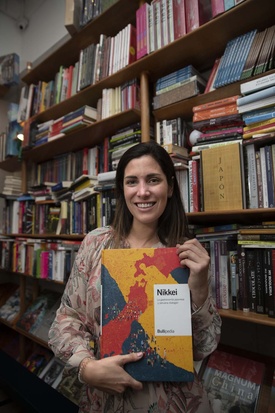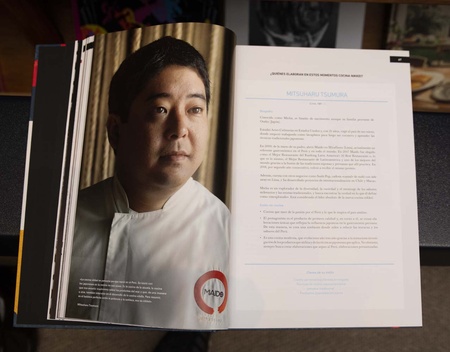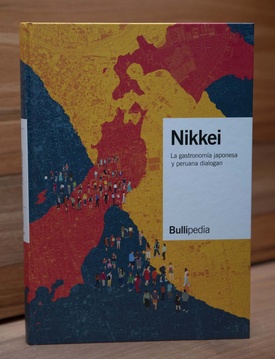
María José García Miró had been fascinated by Nikkei cuisine since she lived in Lima and she loved visiting these restaurants frequently. When he went to Europe, his interest continued, especially when he discovered that many Peruvian restaurants offered Nikkei preparations. For the young graphic designer and chef, that was the starting point to begin an investigation that took shape after studying a master's degree at the Basque Culinary Center and joining the elBullifoundation team, led by innovative chef Ferran Adrià.
“I was looking for gastronomy information and helping in the design area. In 2016, there was the opportunity to develop a book about the Pakta restaurant in Barcelona, whose gastronomic offering is Nikkei, and elBulli Lab sent me to gather information.” Upon returning, Majo, as her friends call her, found herself surrounded by a lot of information and much more that she wanted to discover and develop. “I discussed this excitement and concern with Ferran and his team. This is how we got to work using the Sapiens methodology.”
The result is Nikkei. Japanese and Peruvian gastronomy dialogue , the first book in the Bullipedia collection dedicated entirely to a single type of cuisine, that of Japanese-Peruvian origin. “For me it was fascinating to learn first-hand the history of Nikkei cuisine,” adds Majo, who presented the 448-page work at the Babel bookstore in Miraflores, Lima. The book includes recipes, stories and photographs from several Nikkei chefs such as Mitsuharu Tsumura, Tomás Matsufuji, Diego Oka and Ciro Watanabe, whom he met for research. “It is an act of love for Peru,” said Ferran Adrià from Spain.

HARD WORK
The Sapiens methodology that María José used, devised by Adrià himself and the elBullifoundation team, is an innovative system to connect knowledge. “Being a cook, I knew very well about the pioneering and current references of Nikkei cuisine. I was not lucky enough to meet many of the pioneers, such as Minoru Kunigami, Rosita Yimura, Dario Matsufuji, Humberto Sato or Toshiro Konishi, but researching about them I was able to meet relatives of each of them, who helped me a lot with the research and compilation of photos.”

In addition, it had a team made up of prestigious professionals such as the professor of Japanese art history, David Almazán Tomás, and José Luis Pano Gracia, professor of pre-Columbian and Hispanic art at the University of Zaragoza. “While I was reflecting on writing this book, I discovered that by changing the perspective with which I saw Nikkei cuisine, I not only understood its idiosyncrasies, but by rethinking it, I realized that I can continue creating based on it.”
The latter is something that will serve García Miró for his present and future, already planning a next book. “I was able to understand that Nikkei cuisine is not fashion or trend, but history.” One of the questions that bothered Majo was why the Nikkei use the wok pan if it is a Chinese tool. “The Chinese had arrived in the country many years before and had managed to grow Asian products and introduce several of their tools, including the wok pan. This is how the Japanese were able to access it.”
THE FUTURE IN COCKTAILS
Every book presentation has a toast, and María José García Miró's could not be missing, especially due to the gathering of friends and admirers, as well as the culinary motif that, on this occasion, was accompanied by drinks. And one of the scenarios that she predicts for Nikkei cuisine is also in cocktails. “There is a long road ahead and, probably, the future of Nikkei cuisine lies in the development of its sweet world and its cocktails.”
For the researcher, this can happen when traditional Peruvian pastries, which are deeply rooted in the country, give way to the development of Nikkei pastries, which have been advancing at a steady pace. “Peruvian cocktails are resurfacing thanks, precisely, to their past and the recovery of flavors and techniques, and the search for precision, a characteristic of Japanese culture that has helped introduce several innovations.”
Understanding to create is one of the phrases that stand out in the speech of María José, or María Nikkei, as you can find her on Instagram. Without a doubt, his tribute to this cuisine that “unites two empires separated by their geography and culture” is a way of addressing “a new and tasty identity of his own,” where creativity seems to have no limits.
“Every time I eat a new preparation of this cuisine I am surprised,” says María José, who highlights the flexibility of Nikkei cuisine. “It can be done anywhere in the world. On many occasions it invites the country where it is developed to mix with it, whether with its products, techniques or tools.”
* This article is published thanks to the agreement between the Peruvian Japanese Association (APJ) and the Discover Nikkei Project. Article originally published in Kaikan magazine No. 121, and adapted for Discover Nikkei.
© 2019 Texto y fotos: Asociación Peruano Japonesa










